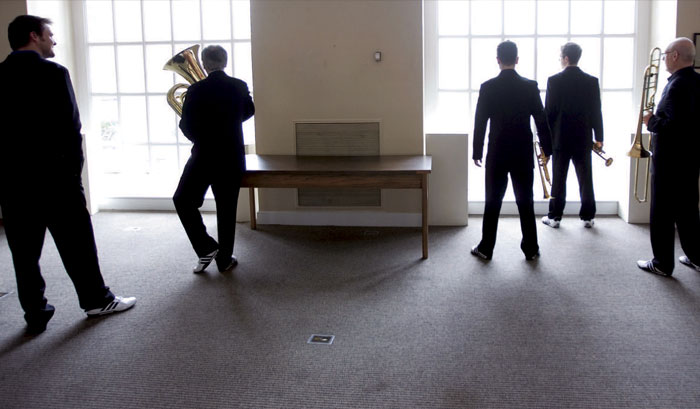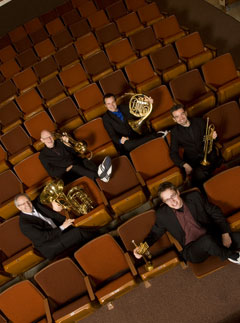


Whether you calculate by fame, sales, longevity, or the respect of their peers, Canadian Brass is the world's leading brass chamber ensemble.
Founded in Toronto in 1970 by trombonist Eugene "Gene" Watts and tuba player Dr. Charles "Chuck" Daellenbach, the quintet has released more than 60 recordings, encompassing classic repertoire, modern compositions, savvy transcriptions, and compelling jazz and pop crossover material.
A perfect example of the latter is the group's latest release, Swing That Music. "It's a tribute to Louis Armstrong," says Daellenbach. "It's our way of creating a meeting that never happened."
We wanted audiences to come to our concerts and hear everything from Bach and Beethoven to early jazz and The Beatles.
Daellenbach and Watts, the ensemble's two original members, aren't merely accustomed to thinking outside the box--time and again, they've built the box from scratch. When they started the group four decades ago, there were few antecedents for an all-brass chamber group.
"The biggest problem," says Daellenbach, "was simply the lack of repertoire. String players have Haydn, Mozart, and Beethoven, but brass players missed the classical chamber music era. Brass instruments didn't even have valves until the 19th century. Our solution was to arrange and transcribe music originally written for other instruments. We stole from the best, from Bach to Mozart."
But that wasn't the group's sole strategy. "We also made a point of not getting locked into a particular sound," Chuck says. "Between the five of us, we'd played in marching bands, concert bands, orchestras, stage bands, territory bands, weekend combos. We wanted audiences to come to our concerts and hear everything from Bach and Beethoven to early jazz and the Beatles." He chuckles. "Come on--for a brass player, what's more important than 'Penny Lane?'"

Once they'd devised a repertoire, the group, in time-honored rock-and-roll fashion, honed their act on the road--albeit in schools rather than bars and nightclubs. "We were very fortunate to start out attached to a fine community orchestra, in Hamilton, Ontario, which had a school outreach program," says Chuck. "In the '70s, many musicians looked at school concerts as an annoyance, but we took it seriously as a laboratory. We learned how to make an appealing program, and then do it again and again."
The result: A group that's received equal acclaim for stellar musicianship and unpretentious, crowd-pleasing performances. "It's one thing to play for an audience, and another for that audience to want to come hear you again," notes Chuck. "Someone can come to our concert and feel very comfortable. We're not playing beyond or above their frame of reference."
With their signature set of gold-plated Yamaha horns, the group displays visual flair as well. In fact, Daellenbach credits Yamaha not only with building great horns, but revolutionizing the way most modern horns are made.
"Back in the '60s," recounts Chuck, "Yamaha hired a very important designer named Renold Schilke. He was the son of a butcher from Green Bay, Wisconsin. Renold was a scientist--he worked on the Manhattan Project--and the principal trumpet player for the Chicago Symphony. He managed to overcome the tuning flaws in the harmonic series--he actually 'fixed' nature so that brass instruments could play perfectly in tune. He changed not just Yamaha instruments, but all brass instruments. Then in 1978 Renold told us it was his dream to create a full set of gold-plated horns, from trumpets to tubas. Before that, no one had ever gold-plated a tuba! But in the end, that became our trademark: a consort of matching gold instruments, all made by Yamaha."
The current Canadian Brass lineup includes Jeff Nelsen on French horn, and Joe Burgstaller and Brandon Ridenour on trumpet (with Ryan Anthony, Jeroen Berwaerts, and Manon Lafrance sometimes subbing for the two principal trumpeters).
"Now we've been around long enough that we're playing with guys who grew up on our instructional books," says Daellenbach. (Trumpeter Ridenour is 23.) "It dawned on me early on that if we were having so much trouble creating a repertoire for brass quintet, what could a poor music teacher do? So we created a pragmatic masterpiece book called Canadian Brass Book of Easy Quintets, which lets first-year students play together as a group. Later we created three more books, and we've sold over 500,000 of them worldwide. Now there are hundreds of thousands of kids growing up in the Canadian Brass style."
Meanwhile, the group remains as committed as ever to their eclectic path. "There are different styles for playing Beethoven, Mahler, Corigliano, or jazz," says Chuck. "Sure, you play W.C. Handy differently than you play Haydn. But they all use the same notes on the same lines and spaces. The important thing is that you play it from your heart--and that's how we've always approached our art."
(Photography Credit: Rusty Russell)
























